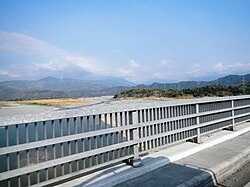Amburayan River
| Amburayan River | |
|---|---|
 View from the Amburayan Bridge along Manila North Road | |
Amburayan River mouth | |
| Location | |
| Country | Philippines |
| Region | |
| Province | |
| City/municipality | |
| Physical characteristics | |
| Source | |
| • location | Cordillera Mountains |
| Mouth | South China Sea |
• location | |
• coordinates | 16°55′15.7″N 120°24′39″E / 16.921028°N 120.41083°E |
• elevation | 0 m (0 ft) |
| Basin features | |
| Tributaries | |
| • right | Bakun River |
Amburayan River is a river in the northeastern portion of island of Luzon in the Philippines. It originates from the Cordillera mountains and traverses the provinces of Benguet, La Union, and Ilocos Sur, where it empties into the South China Sea.[1]
The river serves as the boundary between the provinces of Ilocos Sur and La Union.[2][3]
Source and course
The river's headwaters are a confluence of smaller creeks along the south of barangay Lubo, in Kibungan. Several other tributary creeks merge with the river as it flows along Atok and Kapangan. It then flows along the Sugpon–San Gabriel boundary, the Sugpon–Santol boundary, the Sugpon–Sudipen boundary, the Sudipen–Alilem boundary, the Sudipen–Tagudin boundary, and finally at the Tagudin–Bangar boundary, where its river mouth is located.
In culture
In the Ilocano epic, Biag ni Lam-ang, the hero Lam-ang came to bathe in the Amburayan, as he was soaked in dirt and blood after a battle with headhunters. Assisted by maidens from a nearby village, he shed the dirt and blood which polluted the river and killed the fish and other animals in the water.[citation needed]
References
- ^ See, Dexter A. (27 November 2014). "USAID provides P20 M to protect Amburayan River". Manila Standard Today. Retrieved 12 January 2015.
- ^ "Natural Sceneries: Amburayan River". Province of La Union (Official Website). Retrieved 12 January 2015.[permanent dead link]
- ^ "About Sugpon". Municipality of Sugpon, Ilocos Sur (official website). 5 July 2014. Archived from the original on 8 November 2014. Retrieved 12 January 2015.


